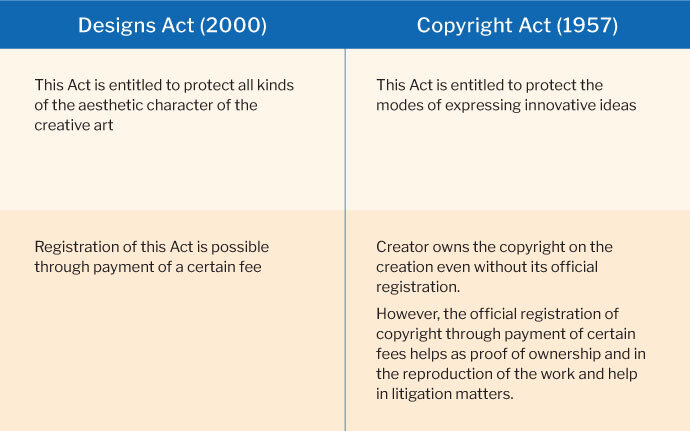How fashion designers can protect their designs?
January 22, 2022 By Shruti NairIn the domain of creative art, fashion designing has established itself as the most lucrative form of Intellectual Property (IP). However, this boon is highly prone to get pirated, copied and stolen. Protecting the designs of the fashion designers under the provision of Industrial Designs led by the Designs Act of 2000 and Designs Rules of 2001 in India is the only solution.
Since designing and creations are an integral part of this creative talent in fashion designers, they must get protection on multiple kinds of intellectual property rights (IPR). This is an intrinsically challenging domain for any IPR law firm. The reason is any kind of design that follows the common popularity of clothing patterns, cannot be protected. Fashion designers must accept that receiving infringements on their designs are part and parcel of their profession. However, in this article, you will understand how this challenge can be resolved to a great extent.
Use Protective Shields
Note that the protection of your logo, design and even brand of your garments are not subject to get copyrighted, but are meant to get trademarked.
The foremost effort is to bring the creative garment under the regulations of trademark law in India, the trade dress gets protected by “passing off” under Section 9(3) of the Trademarks Act 1999, as the common law remedy. It is through this provision that there are enforcement made against any kind of unauthorized use of a creative design. For this purpose, the fashion designer must -
- Register their IP for copyright protection. This registration must remain inclusive of all the original, ornamental, essential, non-essential designs of the designer.
- Attain appropriate patent on the IP. This attainment of patent over the IP will bring in the protection on the novel utility of the designer’s IP.
- Remain in collaboration with a trusted manufacturer. Your manufacturer must have a legal contract signed with you, where strict declarations of protecting the creative art from infringement must be added specifically.
- Add watermark to the IP. By adding a watermark, the IP of the designer will remain protected in the online platforms.
Legislative Shields
There are four specific legal regulations to protect the creations of fashion designers. These are
- Designs Act (2000): Protection from piracy of the original design.
- Copyright Act (1957): Protection of the artistic visualisation of ideas.
- Trademarks Act (1999): Protection of the logo, and trademarks from getting infringed.
- Geographical Indications of Goods (Registration and Protection) Act, 1999: Protection of traditional designer goods with an indication of their specific geographic origins.
- Patent Act (1970): Protection of the innovative material or fabric along with its manufacturing process.
However, these four legal regulations are not enough to protect the designs of fashion designers. For the attainment of a more specific legal protective shield, it is important to consider an amalgamation of different IPR provisions related to the fashion industry. An amalgamated approach of protecting the garments under the aforementioned IPR laws can bring in a more effective way of protecting the intellectually creative properties of fashion designers.
Designs Act vs. Copyright Act
Before proceeding further, you must understand the difference between the Designs Act (2000) and the Copyright Act (1957)

Designs Act (2000)
In the domain of creative art, by the implementation of the Designs Act in the year 2000, the Government of India added the advanced provision of protecting objects comprising the non-functional features. This domain referred to the specific recognition of designs for 10 years which can be further extended for 5 years. The mode of recognition gets categorised under the characteristic presentations in 2-dimensional and/or 3-dimensional platforms. These categorisations are –
- Creatively configured shape,
- Artistic creation of unique pattern,
- Creative ornamentation,
- Innovative compositions of lines or colours are applied to any article.
Piracy Protection
Note that the Designs Act 2000 also offers protection from piracy and infringement under Section 22. Fashion designers can protect their designs by registering their aforementioned categorical creations by availing the Proprietorship on the design. The repeated act of piracy or infringement can also empower the fashion designer to ban the business of the infringer. Through the registration of the design, the fashion designer can hold an absolute monopoly over the IP.
Copyright Act (1957)
The protection of designs for copyright monopoly gets registered under the regulations of the Designs Act of 2000. By considering the Copyright Act of 1957 under the Designs Act of 2000, fashion designers can protect their designs for up to 15 years. However, if the designer decides to follow the process of registration through the regulations of Section 15 under the Copyright Act of 1957, and implements this registration for industrial proceedings, then the designer can avail the design protection till the 50th reproduction of the object.
Thus, it is recommended that the fashion designers register their artwork under the provisions of the Copyright Act of 1957 and the Designs Act of 2000. This will mean holding extensive rights to their creativity. They can consider such amalgamated registration and can protect their-
- Sketches as the artistic creations
- Unique colours through combinations.
Patent Act (1970)
The Patents Act of 1970 through patent registration can offer protection of creative fabric or innovative material as well as its unique manufacturing process.
Trademarks Act (1999)
The registration of a design under the Trademark Act of 1999, offers the independence of adding a logo to the creative design. By this independence, the fashion designers can incorporate the personalised trademarked logo in the design, at the time of creation. This prevents the designs from getting copied or infringed, and thus remains protected.
Geographical Indications of Goods (Registration and Protection) Act, 1999
Under the implementation of Geographical Information or the GIs led by the Government of India, fashion designers can protect their classified designs. The Geographical Indications of Goods (Registration and Protection) Act, 1999 offers classification of designs under the recognised scopes of Geographical Information (GIs), which is meant for protecting designs, patterns, textures and artistic worth of the fabric as well as accessories as per its local representation. For example, Patan’s Patola, Bihar’s Sujini embroidery, Odisha’s Sambalpuri saree, UP’s Chikankari, etc. are all protected under this Act.
Conclusively, fashion designers can protect their designs by having clear consultation with a reputed IPR law firm, and thereby amalgamating the aforementioned Acts for the monopoly of their creative art and design.





